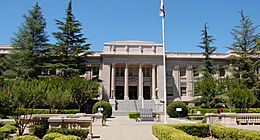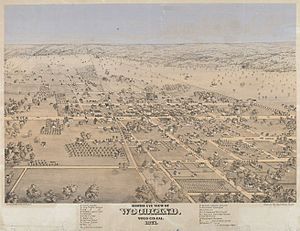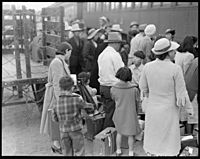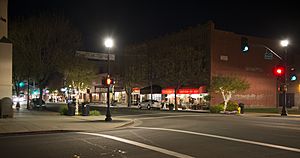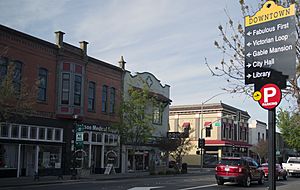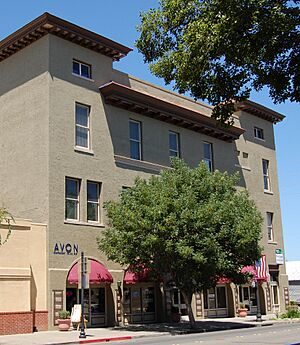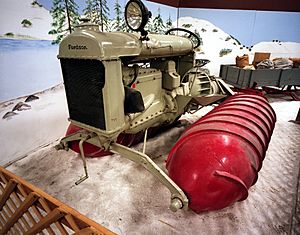Woodland, California facts for kids
Quick facts for kids
Woodland, California
|
|||
|---|---|---|---|
| City of Woodland | |||
|
Clockwise: Yolo County Courthouse; Walnut Street School; Hotel Woodland
|
|||
|
|||
| Nickname(s):
City of Trees
|
|||
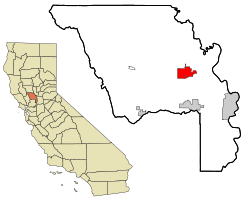
Location in Yolo County and the state of California
|
|||
| Country | United States | ||
| State | California | ||
| County | Yolo | ||
| Incorporated | February 22, 1871 | ||
| Area | |||
| • Total | 15.31 sq mi (39.67 km2) | ||
| • Land | 15.31 sq mi (39.67 km2) | ||
| • Water | 0.00 sq mi (0.00 km2) 0% | ||
| Elevation | 69 ft (21 m) | ||
| Population
(2020)
|
|||
| • Total | 61,032 | ||
| • Density | 3,986.4/sq mi (1,538.49/km2) | ||
| Time zone | UTC-8 (Pacific) | ||
| • Summer (DST) | UTC-7 (PDT) | ||
| ZIP codes |
95695, 95776
|
||
| Area code | 530 | ||
| FIPS code | 06-86328 | ||
| GNIS feature IDs | 1652659, 2412300 | ||
Woodland is a city in and the county seat of Yolo County, California, United States. Located approximately 15 miles (24 km) northwest of Sacramento, it is a part of the Sacramento metropolitan area. The population continues to grow every year, with a growth rate of 0.33% annually, and a current population of 61,873.
Woodland's origins date to 1850 when California gained statehood and Yolo County was established. The area was well irrigated due to the efforts of James Moore, which drew people into farming as the soil was very fertile. The city gained a federal post office in 1861 with the help of Missourian Frank S. Freeman. A year after this, in 1862, the county seat was moved from Washington (present day West Sacramento) to Woodland after Washington was flooded. The addition of a railroad line to Sacramento, and the more recent addition of Interstate 5, helped the city to thrive.
Contents
History
Indigenous culture
Before its settlement by people of European descent, the Woodland area was inhabited by the Patwin, a subgroup of the Wintun Native Americans, further divided into the River and Coastal Patwin. Woodland's indigenous roots stem from the River Patwin, who tended to stay closer to the Sacramento River, as opposed to the Coastal Patwin who lived in small valleys in hills and ranges. The Yolotoi, a tribelet of the Patwin, occupied area near Woodland, and settled a village northwest of Woodland, as well as area close to present-day Knights Landing. Although they didn't have a permanent settlement in present-day Woodland, it is believed that the River Patwin occupied the Woodland area in seasonal camps for hunting and seed gathering. The Yolotoi and their neighboring tribelets had a main trading trail which followed Cache Creek. The exchange of goods between the neighboring tribes of the Nomlaki to the north, the Nisenan to the east, and the Pomo to the west also served as a way of cultural and social interchange between all the tribes. The simultaneous enslavement and spread of disease through the Patwin by the Spanish missionaries quickly had dramatic effects; a malarial epidemic in 1830–33 and a smallpox epidemic in 1837 killed much of the surviving natives. However, some of the first farm hands in the earliest farms in Woodland were Patwin.
Beginnings
In 1851, the year after California became a state and Yolo County was formed, "Uncle Johnny" Morris settled at what is now the corner of First and Clover Streets in Woodland. Two years later Henry Wyckoff arrived and built a store he named "Yolo City". The new Yolo City might have stayed a singular store if Frank S. Freeman, the man responsible for the establishment of the post office, had not bought it and acquired 160 acres (0.65 km2) of land in 1857. Freeman began to develop a town that he hoped would be a trading center for one of the richest crop-growing areas in America. He gave land to anyone who would clear it and build a home. In 1859, Freeman suggested that the town be called Woodland, which the post office accepted. On July 5, 1861, the Woodland Post Office was established and Freeman became Postmaster. He lost no time in developing the town by leasing or selling commercial buildings.
The 1860s were a time of opportunity. The county seat was permanently moved to Woodland after Washington, California (now a part of West Sacramento) flooded. Schools, homes, churches, and a cemetery were built. The town's newspaper, the Daily Democrat and a rail line was built. In 1869, the California Pacific Railroad Company constructed a line between Davisville (now Davis) and Marysville with a Woodland station in the area of College Street and Lincoln Avenue. The rail line expanded and was eventually acquired by Southern Pacific Railroad. The track was then relocated from College Street to East Street, the eastern edge of the city at that point. The addition of the railroad led to the expansion of Woodland. Before the railroad came, people were building primarily from Main Street northward. Later expansion headed west and south.
In 1870 the population of Woodland was estimated to be 1,600 people, 647 of whom were registered voters. Signatures were collected to petition for the incorporation of the town. The City of Woodland was incorporated in 1871 and its residents soon had regular train and telegraph operations, telephone services, gas, water, electricity, street lights, and graveled streets. Byron Jackson, inventor of the centrifugal pump, opened a machine shop in Woodland in 1872. The business moved to San Francisco in 1879, supplying highly efficient pumps for ground water irrigation which transformed agriculture and industry in California.
20th century
Woodland's Chamber of Commerce was founded in 1900. During this time public activism helped Woodland get a library, a city park, and an improved cemetery. In 1910 Woodland was the most populous city in the county, with a population of 3,187. For the next forty years Woodland grew slowly but steadily, based on agriculture-related businesses: three rice mills, a sugar beet refinery, and a tomato cannery were built.
After President Roosevelt issued Executive Order 9066, which authorized military commanders to exclude "any or all persons" from certain areas in the name of national defense, the Western Defense Command began ordering Japanese Americans living on the West Coast to "evacuate" from the newly created military zones. This included many Woodland farming families. At Woodland, was a Woodland Civil Control Station, for check-in, with no overnight accommodations.
The post-war era spurred growth in Woodland; between 1950 and 1980, Woodland's population tripled. In the 1950s Woodland had the most millionaires per capita of any city in California. Industrial plants and distribution centers grew in the northeast, with new subdivisions and shopping centers around the town. Since the late 1960s, there has been greater interest in preserving the town's historic buildings, and many have been restored as homes, offices, stores and museums. Woodland's "Stroll Through History," an annual event, began in 1989 to showcase many of the Victorian homes and other historical sites throughout the city.
In the 1970s Interstate 5 was completed, curving around Woodland. Over time, I-5 and State Route 113 replaced the railroads as major transportation arteries.
21st century
Within the past decade, Woodland has grown, with many additions to the community. Subdivisions have been built (mainly on the east side of town) and several major chain stores opened. This economic growth has encouraged more people to invest in the community and continue its expansion. In 2023, City Manager Ken Hiatt stated an estimate of 161.5 million dollars in public and private investments were to be directed to the city for further development. Woodland has even been named as one of the top 100 places to live in America, ranking at number 55.
Pioneer High School opened for the 2003–04 school year.
In 2018, thanks in part to the establishment of the new community near Pioneer High School, Spring Lake Elementary was created. This makes eleven elementary school in Woodland alone.
Main Street has revived with new restaurants, a new court house, and the expansion of the Old State Theater into a 10-screen multiplex. With rumors spreading about the possible future of a Woodland Research and Technology Park, a hub dedicated to serving research and technology companies from surrounding areas, surely the population will continue to grow.
Geography and climate
Woodland is located on flat land in the Central Valley (California), with the Yolo Bypass and the Sacramento River to the east and the Capay Valley and the Coast Range to the west. Woodland is a part of the Sacramento Metropolitan Area but it retains a "small town" feeling partly due to the mileage between the city and the neighboring cities. It is located just southeast of the county's geographical center, and is one of the largest cities north of Sacramento along Interstate 5 until Redding. Interstate 5 enters the city from the east and curves northward over the remainder of Woodland, exiting northwest. SR 113 enters the city from the south as a controlled access freeway and merges with the I-5, then diverges leaving the city northward as a standard two-lane road. The city is surrounded by farmland.
Woodland calls itself the "City of Trees". Valley oaks are the predominant native species planted around the city.
Climate
Woodland has a Mediterranean climate with dry, hot summers and cool, relatively wet winters, as with the rest of California's Sacramento Valley. The rainy season is generally from October through April. In the hottest month, July, average high temperatures range from 94 °F 58 °F. Average lows range from 58 °F in July to 38 °F in December and January. January is typically the wettest month with about 3.92 inches (100 mm) of rain. All-time extremes for Woodland are 15 °F and 114 °F.
It has a zone 9b botanical plant hardiness climate zone, like almost all of the Sacramento Valley.
Summer brings warm days, with temperatures frequently in the upper 90s, but the "Delta Breeze" that blows into the valley through the Carquinez Strait usually makes for comfortable evenings and nighttime temperatures in the upper 50s. Occasional heat waves raise the temperature above 100 degrees. During late fall and throughout the winter months, Woodland experiences cooler temperatures, rain from storms originating in the Pacific Ocean and Gulf of Alaska, tule fog, and a few mornings of frost and freezing conditions. When the chilling fog does not burn off, daytime highs may remain in the 40s or low 50s for several consecutive days. Snow is extremely rare in Woodland; the last measurable snowfall occurred on January 28, 2002. The Sierra Nevada mountains, about 60 miles to the east of Woodland, receive significant amounts of snow each winter, contributing to the cool weather. The cool and wet weather becomes much less frequent in April and May as the days gradually get warmer.
| Climate data for Woodland, California (1991–2020 normals, extremes 1906–present) | |||||||||||||
|---|---|---|---|---|---|---|---|---|---|---|---|---|---|
| Month | Jan | Feb | Mar | Apr | May | Jun | Jul | Aug | Sep | Oct | Nov | Dec | Year |
| Record high °F (°C) | 78 (26) |
82 (28) |
87 (31) |
100 (38) |
106 (41) |
114 (46) |
114 (46) |
113 (45) |
116 (47) |
105 (41) |
89 (32) |
76 (24) |
116 (47) |
| Mean daily maximum °F (°C) | 56.2 (13.4) |
61.7 (16.5) |
67.5 (19.7) |
74.0 (23.3) |
81.9 (27.7) |
89.6 (32.0) |
94.9 (34.9) |
94.3 (34.6) |
90.3 (32.4) |
79.7 (26.5) |
65.4 (18.6) |
56.4 (13.6) |
76.0 (24.4) |
| Daily mean °F (°C) | 46.9 (8.3) |
51.2 (10.7) |
55.7 (13.2) |
60.4 (15.8) |
67.0 (19.4) |
73.2 (22.9) |
76.5 (24.7) |
75.8 (24.3) |
73.1 (22.8) |
65.0 (18.3) |
54.0 (12.2) |
47.0 (8.3) |
62.2 (16.8) |
| Mean daily minimum °F (°C) | 37.6 (3.1) |
40.7 (4.8) |
43.9 (6.6) |
46.9 (8.3) |
52.2 (11.2) |
56.8 (13.8) |
58.2 (14.6) |
57.3 (14.1) |
55.8 (13.2) |
50.4 (10.2) |
42.6 (5.9) |
37.5 (3.1) |
48.3 (9.1) |
| Record low °F (°C) | 15 (−9) |
25 (−4) |
25 (−4) |
30 (−1) |
35 (2) |
41 (5) |
46 (8) |
44 (7) |
38 (3) |
31 (−1) |
24 (−4) |
19 (−7) |
15 (−9) |
| Average precipitation inches (mm) | 4.46 (113) |
4.20 (107) |
2.82 (72) |
1.32 (34) |
0.72 (18) |
0.21 (5.3) |
0.00 (0.00) |
0.04 (1.0) |
0.16 (4.1) |
0.81 (21) |
1.95 (50) |
3.81 (97) |
20.50 (521) |
| Average snowfall inches (cm) | 0.0 (0.0) |
0.0 (0.0) |
0.0 (0.0) |
0.0 (0.0) |
0.0 (0.0) |
0.0 (0.0) |
0.0 (0.0) |
0.0 (0.0) |
0.0 (0.0) |
0.0 (0.0) |
0.0 (0.0) |
0.0 (0.0) |
0.0 (0.0) |
| Average precipitation days (≥ 0.01 in) | 10.8 | 9.3 | 7.8 | 5.0 | 2.9 | 0.9 | 0.0 | 0.2 | 0.7 | 2.8 | 6.0 | 9.1 | 55.5 |
| Average snowy days | 0.0 | 0.0 | 0.0 | 0.0 | 0.0 | 0.0 | 0.0 | 0.0 | 0.0 | 0.0 | 0.0 | 0.0 | 0.0 |
| Source: NOAA | |||||||||||||
Demographics
| Historical population | |||
|---|---|---|---|
| Census | Pop. | %± | |
| 1880 | 2,257 | — | |
| 1890 | 3,069 | 36.0% | |
| 1900 | 2,886 | −6.0% | |
| 1910 | 3,187 | 10.4% | |
| 1920 | 4,147 | 30.1% | |
| 1930 | 5,542 | 33.6% | |
| 1940 | 6,637 | 19.8% | |
| 1950 | 9,386 | 41.4% | |
| 1960 | 13,524 | 44.1% | |
| 1970 | 20,677 | 52.9% | |
| 1980 | 30,235 | 46.2% | |
| 1990 | 39,802 | 31.6% | |
| 2000 | 49,151 | 23.5% | |
| 2010 | 55,468 | 12.9% | |
| 2020 | 61,032 | 10.0% | |
| U.S. Decennial Census | |||
2010
The 2010 United States Census reported that Woodland had a population of 55,468. The population density was 3,624.7 inhabitants per square mile (1,399.5/km2). The racial makeup of Woodland was 23,134 (38.5%) White, 849 (1.4%) African American, 261 (0.4%) Native American, 4,687 (7.8%) Asian, 207 (0.3%) Pacific Islander, 12,488 (22.5%) from other races, and 2,868 (5.2%) from two or more races. Hispanic or Latino of any race were 29,380 persons (48.9%).
The Census reported that 54,483 people (98.2% of the population) lived in households, 156 (0.3%) lived in non-institutionalized group quarters, and 829 (1.5%) were institutionalized.
There were 18,721 households, out of which 7,833 (41.8%) had children under the age of 18 living in them, 9,723 (51.9%) were opposite-sex married couples living together, 2,649 (14.1%) had a female householder with no husband present, 1,176 (6.3%) had a male householder with no wife present. There were 1,278 (6.8%) unmarried opposite-sex partnerships, and 113 (0.6%) same-sex married couples or partnerships. 4,097 households (21.9%) were made up of individuals, and 1,623 (8.7%) had someone living alone who was 65 years of age or older. The average household size was 2.91. There were 13,548 families (72.4% of all households); the average family size was 3.41.
The population was spread out, with 15,233 people (27.5%) under the age of 18, 5,574 people (10.0%) aged 18 to 24, 15,254 people (27.5%) aged 25 to 44, 13,383 people (24.1%) aged 45 to 64, and 6,024 people (10.9%) who were 65 years of age or older. The median age was 33.7 years. For every 100 females, there were 97.0 males. For every 100 females age 18 and over, there were 94.2 males.
There were 19,806 housing units at an average density of 1,294.3 units per square mile (499.7 units/km2), of which 10,472 (55.9%) were owner-occupied, and 8,249 (44.1%) were occupied by renters. The homeowner vacancy rate was 2.0%; the rental vacancy rate was 6.1%. 30,543 people (55.1% of the population) lived in owner-occupied housing units and 23,940 people (43.2%) lived in rental housing units.
2000
As of the census of 2000, there were 16,751 households, and 12,278 families residing in the city. The population density was 4,765.7 inhabitants per square mile (1,840.0/km2). There were 17,120 housing units at an average density of 1,660.0 units per square mile (640.9 units/km2). The racial makeup of the city was 48.5% White/Caucasian, 1.3% African American (1.3% by December 2006), 1.5% Native American, 3.8% Asian (7.4% by December 2006), 0.3% Pacific Islander, 21.5% from other races, and 4.9% from two or more races. Hispanic or Latino of any race were 61.8% of the population.
There were 16,751 households, out of which 40.1% had children under the age of 18 living with them, 54.8% were married couples living together, 12.9% had a female householder with no husband present, and 26.7% were non-families. 21.0% of all households were made up of individuals, and 8.4% had someone living alone who was 65 years of age or older. The average household size was 2.89 and the average family size was 3.37.
In the city, the population was spread out, with 29.7% under the age of 18, 9.6% from 18 to 24, 30.3% from 25 to 44, 19.9% from 45 to 64, and 10.5% who were 65 years of age or older. The median age was 32 years. For every 100 females, there were 96.2 males. For every 100 females age 18 and over, there were 92.5 males.
The median income for a household in the city was $44,449 ($50,309 in December 2006), and the median income for a family was $48,689. Males had a median income of $34,606 versus $27,086 for females. The per capita income for the city was $18,042. About 9.2% of families and 11.9% of the population were below the poverty line, including 14.0% of those under age 18 and 7.3% of those age 65 or over.
Economy
Woodland and the immediate surrounding area's economy has largely been based on agriculture. To this day, Yolo County is one of the largest crop producers in the state. Ranking in America's top 20 for total commodity production, Yolo remains a leader in agricultural production. The transportation industry has played a large part in Woodland's economy, as well. With heavy agricultural production comes the need to transport it. While maintaining the large role that agriculture and transportation still play in the town's activities, over the years Woodland has branched out into other sectors as well.
The industrial sector has grown in Woodland as is seen by the numerous manufacturing and warehouse centers. Modular homes are one of the largest manufactured goods in town. Several major retail stores have warehouses in Woodland or just outside the city limits.
When the price of homes rose in California during the first half of the decade, Woodland was near the front of the wave due to many factors including proximity to Sacramento and its maintenance of a small community feeling. Its' convenient location, as well as its strong sense of community has made Woodland a desired place to live. As a result, in 2002 Woodland had the highest percentage increase in property value in the nation.
Ease of access to the city provided by the close proximity of I-5 and I-80 as well as the Sierra Northern Railway and the California Northern Railroad are most likely why businesses have done so well in Woodland. Woodland's short distance from the Sacramento and San Francisco metro areas also provide businesses another reason to set up shop in town.
Top employers
According to the city's 2020 Comprehensive Annual Financial Report, the top employers in the city are:
| # | Employer | # of Employees |
|---|---|---|
| 1 | Target Distribution Center | 1,325 |
| 2 | Yolo County | 1,300 |
| 3 | Pacific Coast Producers | 1,100 |
| 4 | Walgreens | 600 |
| 5 | City of Woodland | 309 |
| 6 | Truck Accessories | 209 |
| 7 | Alderson Convalescent Hospital | 150 |
| 8 | PGP International | 149 |
| 9 | Cottonwood HC Inc | 118 |
| 10 | Silvercrest | 103 |
Arts and culture
The First Friday Art Walk is a monthly event which promotes the work of local and international artists.
Annual events
The Yolo County Fair is held in Woodland in the middle of August each year, running Wednesday afternoon through Sunday evening. Started in 1935 (and located at the current site since 1940), it is the largest free-admission fair in the state of California, and as such, people come from all over Northern California to enjoy this event. There are demolition derbies in the fairground's arena, local FFA and 4-H competitions going on, as well as several other agricultural related competitions. One of the newest and most popular attractions of the county fair is the "Yolo Idol Search" based on the TV show American Idol. There are also several exhibition halls where fair-goers can peruse through stands set up by local businesses and groups.
In 2008 The Sacramento Valley Scottish Games & Festival celebrated its 11th year at the Yolo County Fairgrounds. The Games feature a wide variety of activities, drawing up to 20,000 visitors each year. The "Games" are the third oldest in the United States. It is also the second largest event in Yolo County. The Games are held the last Saturday and Sunday of April.
The Stroll Through History is a widely celebrated event in Woodland. It is used to increase awareness and appreciation of the history and heritage of Woodland. There are guided walking tours through several historic areas of Woodland, displays of historic equipment, vehicles, and other historical finds, as well as tours inside several of Woodland's historic Victorian homes. Some of the Stroll Through History is free while other parts require tickets purchased in advanced. This event usually takes place on a Saturday within the first two weeks of September.
The Woodland Dynamite Chili Cook-off is a newer addition to Woodland's cultural activities. Beginning in 1998, the cook-off has drawn a lot of people out to try chili cooked from various members of the community. This event also includes other activities such as bounce houses, pony rides and games for the children; live music as well as other food and drink for the adults. The cook off is held the third Saturday of each September at Rotary Park in the Yolo County Fairgrounds.
The City of Woodland and Woodland Chamber of Commerce put on a Christmas parade each year that draws a crowd of around 30,000 people in downtown Woodland. It is one of the largest holiday parades in Northern California. Started in 1964, the Woodland Christmas Parade now has around 150 entries each year, including marching bands, floats, dance groups, military units, and novelty entries from local groups as well as from the surrounding area. The parade runs through Woodland's "Historic Downtown", along Main Street beginning at the intersection of Main Street and California Street and ending at the intersection of Main Street and 6th Street.
Museums and other points of interest
There are several small museums in Woodland. The Heidrick Ag History Center is an agriculture and transportation museum. It showcases rare and unique agricultural machinery and vehicles dating from the late 19th century to the middle of the 20th century. It also has a 45,000-square-foot (4,200 m2) events and exhibition hall which features rotating exhibits.
Reiff's Antique Gas Station Automotive Museum has car culture exhibits from the 1950s and 1960s. The antique gas station displays old fashioned gas pumps, gas station signs and logos. Additional exhibits include the old time general store, diner and movie theater.
Another local museum is the Yolo County Historical Museum. It is located on 2.5 acres (10,000 m2) in the former home of Woodland pioneers William and Mary Gibson. The construction of the house itself was started in 1857 and is listed on the National Register of Historic Places. The museum acquired the property in 1975 and it houses furnishings and artifacts dating from the 1850s to the 1930s. Locally called The Gibson Mansion, the house and the property depict everyday living from that era as well as changing exhibits regarding Yolo County history.
Another site of interest is the Woodland Public Library. The original structure was funded by Andrew Carnegie and was constructed in 1905. The Woodland Public Library is the oldest library funded by Carnegie in California that is still in operation.
The Woodland Opera House is a California Historical Landmark and a California State Historic Park that was originally built in 1885 and was rebuilt due to fire in 1895–1896. The opera house was rebuilt on the original site with some of the intact bricks and foundation. It was the first opera house to serve the Sacramento Valley. Some notable performers on its stage include John Philip Sousa and his band, Verna Felton, and Madame Helena Modjeska. Closed in part due to the rise of the motion picture industry, and partly due to a lawsuit involving an injury, the opera house was closed from 1913 until recently. Renovations allowed for the historic building to be opened again and it is now an acting venue in town. Several major productions are shown throughout the year, and many bands use the venue.
Education
Woodland Joint Unified School District services ten elementary schools, one charter school, two middle schools, two high schools, one continuation high school and the adult education center in the area. In 2015, current Woodland Joint Unified School District Trustees include; Elaine Lytle, President; Tico Zendejas, Vice President; Morgan Childers, Clerk; Sam Blanco III Member; Michael Pyeatt, Member; Dr. Cirenio Rodriguez, Member; and Tania Tafoya, Member.
There are several private schools in town. They include Woodland Christian School, a former ministry of the LifePointe Church (formerly known as First Baptist), which offers classes for children from preschool through high school; Holy Rosary Parish School, run by Holy Rosary Parish, offers enrollment from preschool to 8th grade; Montessori Children's House offers enrollment from preschool through 6th grade; Woodland Adventist School gives classes from preschool to 8th grade; a private school entitled Abby's School has enrollment for preschool and kindergarten; and Cornerstone Christian Academy, using A.C.E.'s School of Tomorrow curriculum, offers classes for pre-school through high school aged students.
Yuba Community College District oversees Woodland Community College, a now fully accredited college.
Media
The local newspaper of Woodland is the Daily Democrat. It was established in 1857 before the City of Woodland was incorporated. The Sacramento Bee is also widely read in town. The WAVE (Woodland Access Visual Enterprises) Channel 21 is Woodland's Public-access television cable TV station which airs footage from a variety of community activities, including local high school football games, the Yolo County Fair, the Woodland Christmas Parade, as well as televised classes from Woodland Community College Educational-access television program. Anyone from the community is able to air approved content.
Several movies have also been filmed, at least partially, in Woodland. They include the movies Farewell Bender, Blood Sport, Letters from a Killer, and selected scenes from Three Men and a Baby.
The documentary Bigger, Faster, Stronger features several scenes in Woodland, and includes interviews with football players from the Woodland Wolves and the Pioneer Patriots.
The cast and crew of the HBO series Big Love filmed in Woodland as part of a week-long filming stint that took them all over Yolo and neighboring counties.
Infrastructure
Transportation
Woodland is served by Yolo County Transportation District commonly termed 'YOLOBUS'. There are many routes to and from Downtown Sacramento, Davis, Cache Creek Casino Resort, and other areas of Yolo County. Two freeways run through the city, State Route 113 and Interstate 5. Surface streets in town run north and south or east and west. The roads (especially in the older part of the city) are straight, forming a grid. Woodland has also added a transit service called the Beeline by Yolobus that works almost like a rideshare.
Most transportation is by automobile, though it is common to walk or ride bicycles.
Utilities
Woodland receives its natural gas and electricity services from Pacific Gas & Electric. The City of Woodland provides water and Waste Management removes waste.
Healthcare
The largest medical facility in town is Woodland Healthcare, a member of Dignity Health. Other facilities include Sutter Health and private practices.
Notable people
- José Antonio Bowen - president of Goucher College
- Scott Brant - 2003 U.S. Speedway National Champion
- Jillian Camarena - champion shot putter, 2008, 2012 Summer Olympics
- Thomas Haden Church - Academy Award-nominated actor, born Thomas Richard McMillen
- Bobbie Cryner - country singer-songwriter
- May Dexter Henshall - county superintendent of schools, California Library Hall of Fame
- George Herms (born 1935), American artist
- John Didion - professional football player
- Vicente Escobedo - boxer, 2004 Summer Olympics
- Loreto Garza - California Boxing Hall of Famer and WBA junior welterweight world champion (1990–1991)
- Eddy Howard - singer and bandleader
- Sagen Maddalena - 2024 Olympic Silver Medialist
- Hunter Moore - internet personality
- Alyssa Nakken - The first full-time female coach in MLB history
- Dustin Pedroia - professional baseball player
- Craig Penrose - former professional football player
- Neil C. Roberts- former Petty Officer 1st Class, Navy SEAL
- Charles R. Schwab - founder of eponymous stock brokerage firm
- Mungo Thomson - visual artist
- Tony Torcato - professional baseball player
- Frona Eunice Wait - journalist and author
- Paul Wulff - college and NFL football coach
- Jack Lloyd Yerman - 1960 Olympic champion and football player
Sister cities
Woodland has one sister city, as designated by Sister Cities International:
See also
 In Spanish: Woodland (California) para niños
In Spanish: Woodland (California) para niños


